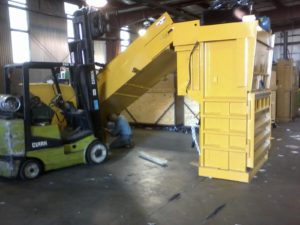Installing a new baler or compactor in your facility is going to help bring your recycling and waste management program to the next level. Now, the challenge is finding that perfect location! Here are some tips to place the baler or compactor so it best interfaces with your other equipment and increases your overall material handling productivity.
Some Considerations for Choosing the Ideal Location for your Baler or Compactor:
- Does the baler/compactor need to be close to specific storage, loading, or dock areas?
- Will their be adequate access to delivery of incoming materials?
- Does the area have sufficient ceiling height space to fit the equipment?
- Will the floor be able to support the baler or compactor? Horizontal balers, vertical balers, automatic balers, and compactors will all have individual specifications for the required depth of cement. Compactors are usually bolted to the cement, and balers are also bolted to the cement in areas where earthquakes are likely.

- Will their be adequate space for needed maintenance or repairs? Be sure there is easy access to key areas, such as those with the heaviest components.
- Will their be adequate space for accessories such as conveyors, chutes, etc? Will accessories be needed in the future?
- Is there existing equipment or processes that the baler or compactor needs to interface with?
- How close would the equipment be to floor drains or grates? Be careful to not position the equipment too close to floor drains, in case of a hydraulic leak.
- Does the location allow for adequate room and protection from loaders and/or forklifts?
- Does the temperature of the location drop below freezing? If so, oil reservoir heaters can be added to the baler and compactor equipment.
If you would like some assistance is finding the right location for your new equipment or need to know more specifications for your equipment, please contact us at (507) 886-6666. Harmony Enterprises also has Service and Install Companies in your area who could help you determine the best placement for your baler or compactor.
Learn more about Baler Installations and Electrical Requirements.
